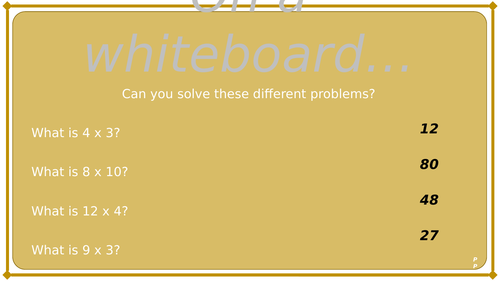




Please find within this download:
A detailed and engaging PowerPoint, Differentiated (SEN, LA, MA, HA & Mastery) Worksheet with Answer Sheet for a complete lesson on this National Curriculum Statement: Recall and use multiplication and division facts for the 3, 4 and 8 multiplication tables.
The PowerPoint has the following features:
→ Differentiated starter activity (plus extension)
→ Extremely logical and simplistic explanations with animated examples
→ Both practise and quiz mode available within the PowerPoint
→ Learning Objective and differentiated success criteria which is clearly visible for all children
→ Animated count-down timer so children know how long they have left of the lesson (this is also good for teachers as it reminds you when to do mini-plenaries/feedback/etc).
The Word Document has the following features:
→ Differentiated activities on one sheet from SEN, LA, MA, HA and Mastery Challenge
→ Coloured activity boxes to help you quickly assign tasks to children
→ Learning objective and short date (which automatically updates to the day you open the document)
→ Differentiated success criteria that link with the PowerPoint
→ Answer sheet included for all questions
Explore our other Year 3 Multiplication & Division Lessons:
Recall and use multiplication facts for the 3, 4 and 8 multiplication tables
Write and calculate mathematical statements for division using the multiplication tables that they know, including for two-digit numbers times one-digit numbers, using mental and progressing to formal written methods.
Write and calculate mathematical statements for multiplication using the multiplication tables that they know, including for two-digit numbers times one-digit numbers, using mental and progressing to formal written methods
Solve problems, including missing number problems, involving multiplication and division, including positive integer scaling problems and correspondence problems in which n objects are connected to m objects
Get this resource as part of a bundle and save up to 50%
A bundle is a package of resources grouped together to teach a particular topic, or a series of lessons, in one place.
Something went wrong, please try again later.
This resource hasn't been reviewed yet
To ensure quality for our reviews, only customers who have purchased this resource can review it
Report this resourceto let us know if it violates our terms and conditions.
Our customer service team will review your report and will be in touch.